The Epic Continues was a presentation that angled to support a planned 1986 extension of Kenner's Power of the Force action figure range. It was based on original characters and vehicles, stemming from a new plot line created by Kenner designer Tim Effler, that concerned the genetics master Atha Prime (a name that Effler created that alludes to the term 'number one evil') ruler of dark worlds, who had been freed from exile following the death of Emperor Palpatine. Striking at the Rebel Alliance, he was forced to do battle with Luke Skywalker, Han Solo, and the Mongo Beefhead Tribesmen. Meanwhile, Grand Moff Tarkin, who had evaded death at the Battle of Yavin, had returned to take control of the Galactic Empire.
Many of the new figures and vehicles were inspired by elements from the films and were designed to illustrate Kenner's understanding of George Lucas' vision. The ideas took shape in concept art and prototypes that had been woven into a narrative created by Effler, who wrote a finalized list of characters that he worked on in 2D form. Some of vehicles were pulled from previous, unused concepts, while others were developed by Effler in concert with Boudreaux. Ultimately Effler was responsible for the bulk of the new designs, while Boudreaux who also contributed, was tasked with creating the vehicle models with assistance from several in-house model makers. Most of the prototypes were kitbashed, including some with minor alterations to existing designs. The proposal was presented to Lucasfilm Ltd. Effler recalls the concept of the line continuing being approved by them, but not by Kenner's own management. As a result none of the figures were produced, and the plot line was rendered non-canon. In the mid 1990s, several of the vehicles and droids from the line were canonized in the short story The Battle of Cadinth, and in the early 2000s Abel G. Peña made several attempts to canonize Atha Prime. Though the character was not directly made canon, one inspired by Prime, a genetic terrorist later revealed to be named Zeta Magnus, was.
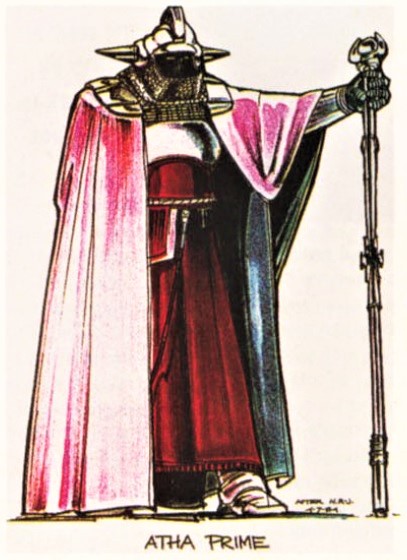
Atha Prime, genetics master.
Atha Prime, a genetics master and ruler of the dark worlds, has been freed from his exile by Emperor Palpatine's death at the Battle of Endor. With his army of shock troop Clone Warriors, he moves against the Rebel Alliance, decimating planets held in their thrall. They strike from the Annihilator, a city-sized capital ship that attaches to Prime's personal fighter, the Apex Invader. The fighter is piloted by Blue-Four, who doubles as Prime's confidant.
At the same time, the Galactic Empire, headed by Grand Moff Tarkin, makes their own bid for power, using a wide variety of attack droids to do their bidding. Tarkin survived the Battle of Yavin and chose the wake of Palpatine's death to make his return. They also employ All Terrain Ion Cannons and operate from an Imperial Outpost.
To combat the new threat of Prime, war hero Han Solo and Jedi Knight Luke Skywalker are called upon. They are aided in their efforts by the Mongo Beefhead Tribesmen from Tatooine. At their disposal are a wide choice of combat vehicles, such as Tandem X-wings and various landspeeders.
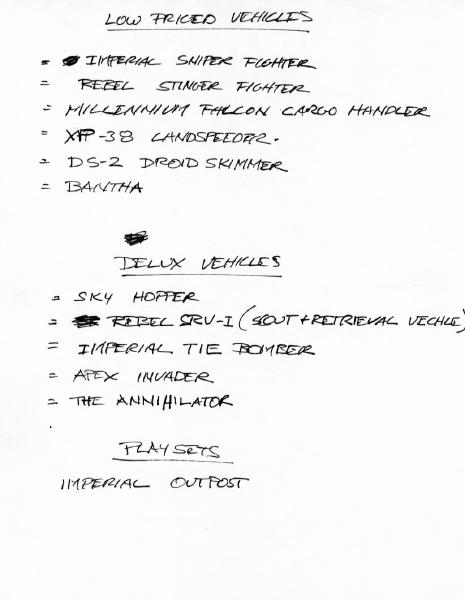
Tim Effler's handwritten list of vehicles given to colleague Mark Boudreaux during the project
In 1984, Kenner employee Tim Effler and his design team, including colleague Mark Boudreaux, were tasked with brainstorming ways to extend the Star Wars toy line, in an effort to sustain the brand without a new film on the horizon. Previously, the company had enjoyed success with their lines of Boudreaux's Mini-Rigs and Effler's Body-Rig concepts . Both were successful lines of small vehicles inspired by, as opposed to based on, other vehicles appearing in the films. They had been created to fill in the gap between the relatively cheap action figures and the more expensive film-based vehicles.
Kenner's designers would sometimes tinker with existing toy vehicles, modifying them in a kitbashing process— effectively scrounging pieces and elements from them, or even random model kits to create entirely new designs. Effler's The Epic Continues team used several preexisting, unreleased Star Wars concept models along with new ideas to create a range of figures and vehicles for a toy line that might have seen release in 1986. Their project goal was to produce a presentation that Kenner's managment would take to Lucasfilm.
The line would feature original characters and vehicles that could exist within the Star Wars universe. Effler had formulated an original plot line involving the characters and vehicles that might continue the Star Wars story after . He created a new enemy, Atha Prime, who had begun terrorizing the galaxy in the wake of Emperor Palpatine's death.
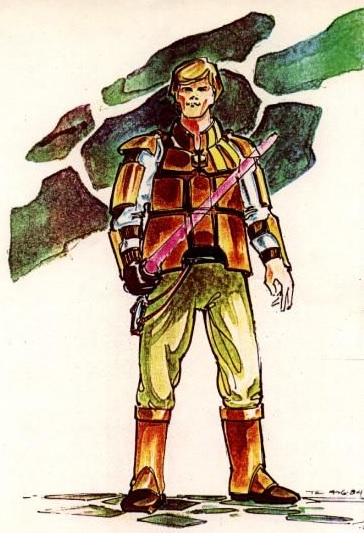
Kenner's concept art for Luke Skywalker.
The design team utilized a number of different methods to present their ideas to Lucasfilm Ltd. This included black-and-white sketches, hand colored drawings, and physical prototypes that they had photographed. All were placed in an 8.5" by 11" binder that formed the basis of the presentation. Several of the figures were modifications or extrapolations of existing figures. Han Solo was redesigned with new, more "heroic" attire, while Luke Skywalker was given lightweight fencing armor, apparently worn by training Jedi Knights. One of the new "hero" figures was to be the Mongo Beefhead Tribesman, one of the few to be actually made into a prototype. The prototype was a kitbashed one—made up of a modified Quarren's torso, limbs and head (positioned at 90 degrees so his neck became his mouth), an Ithorian's (Kenner's 1978 Hammerhead action figure ) arms, and "4-LOM's" chest harness.
In an attempt to push the Star Wars saga in a new direction, Atha Prime—a genetics master who had orchestrated the Clone Wars, was chosen to drive the new narrative. In their presentation of Prime, Kenner incorporated a brief description of the character and a color concept drawing. The drawing for Prime was in fact slightly modified from Nilo Rodis-Jamero's designs for the Emperor's Royal Guards, from Return of the Jedi. Modifications included changes to the character's staff and headpiece. To accompany Prime, they designed the Clone Warriors. In the way of characters affiliated with the Galactic Empire, the designers decided to re-introduce Grand Moff Tarkin, who had been apparently killed at the conclusion of Star Wars: Episode IV A New Hope. They had failed to create a figure of Tarkin during the original Star Wars run and intended to rectify that. To present the idea of the figure, a promotional still of Peter Cushing in the role from was used.
A variety of droid figures were proposed for the line, including a black Imperial Sentry Droid, much like R5-J2 from Return of the Jedi. Three Imperial Attack Droids, designated A, B, and C, had prototypes made. Several elements of these were kitbashed from earlier figures. The pilot droid Blue-Four was also designed, as part of Atha Prime's faction.
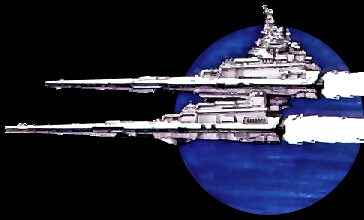
Concept art for the Annihilator.
For new vehicles to go with the line, Boudreaux was included a previously made but not produced group of prototypes and designs based on or inspired by the craft seen in the original trilogy, along with Effler's new concepts on which he'd built Kenner's proposed Star Wars narrative. They would be categorized into two price ranges: "low priced vehicles" and "deluxe vehicles." Boudreaux and three model makers kitbashed the models, including the Tandem X-wing, inspired by "lumbering World War II airplanes." The ship was painted in negative colors to those of a standard X-wing, despite Boudreaux's admission that there was no need for a night fighter in space. To accompany the Millennium Falcon toy that had been produced years earlier, a new Millennium Falcon Cargo Handler was designed by Effler, which could be attached to the bow of the original toy. Inspired by the Star Destroyer design from the original trilogy. Effler requested concept sketches of his Annihilator, a large mobile command base for Atha Prime and his Clone Warriors. His design consisted of two Star Destroyers attached, one on top of the other. The Apex Invader, a personal vehicle for Prime, would have been able to attach to the top of the vessel. Other spacecraft in the line would be the pre-existing TIE/sa bomber and X-wing fighter. The TIE Bomber was presented with photocopied artwork by Joe Johnston.
For land vehicles, the designers formulated two landspeeders: the XP-36 and the XP-38, which had been mentioned in A New Hope. The former was intended to be a high-performance, light vehicle, while the latter was a state-of-the-art speeder. A prototype was made of the XP-36, while the XP-38 existed only as concept art. The XP-38 would serve as Skywalker's personal vehicle within the storyline. Another craft inspired by the films was a type of T-47 airspeeder modified for use on desert worlds. One all-new nearly produced toy was the Scout and Retrieval Vehicle, which could carry damaged X-wings and airspeeders. An earlier version of the toy had been proposed years earlier as an unseen vehicle used by Rebels on Hoth, but Kenner's new version was presented two ways: as a slightly modified version of the original toy's prototype, and a heavily modified version presented as concept art.
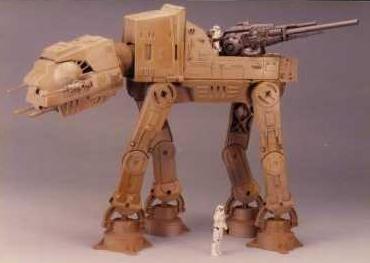
The AT-IC prototype.
Working from the All Terrain Armored Transport from Star Wars: Episode V The Empire Strikes Back, an "All Terrain Ion Cannon" prototype was made. Effler's design consisted of an AT-AT with its back and top sheared off, and a large cannon placed in their stead. In addition to the original vehicles, the new Imperial sniper fighter, the already established AT-AT, the T-16 skyhopper, the "snowspeeder" version of the T-47, and the X-34 landspeeder would be included in the line. For the Skyhopper, Kenner simply reused an original design by Joe Johnston, as they had done with the TIE Bomber.
A single playset was conceived for the new line, dubbed "Imperial Outpost." The concept art was designed by Boudreaux, who combined pre-existing elements such as a gun tower from the Death Star with the landing platform and bunker complex seen on Endor in Return of the Jedi. In addition to the reintroduction of Tarkin, Kenner proposed a bantha figure, which they had considered producing for the original toy line. Unlike Tarkin, the bantha was presented as concept art.
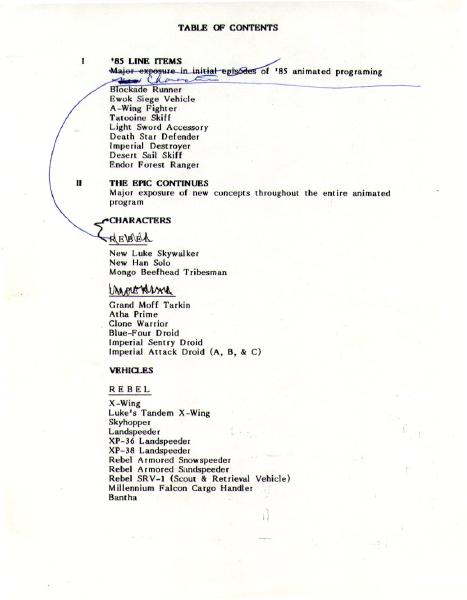
Presentation binder table of contents
The Kenner designers were shut out of the presentation management gave to Lucasfilm Ltd., using their sketches and photos, alongside proposals for figures from the existing films and the two television series, Star Wars: Droids and Ewoks. It is possible that Kenner also intended to have their new plotline accompanied by a third animated series. Notes were also made for two otherwise undocumented vehicles: Boudreaux's Rebel stinger fighter and Effler's DS-2 droid skimmer.
The outcome of the meeting is disputed to a point. Effler states that Lucasfilm Ltd. approved Kenner's plans to continue their Star Wars line, but that he wasn't interested in supporting it with new media. Kenner hierarchy continued with their plan to cancel the line, after market research in early 1984 had revealed waning interest.
In 1995 Boudreaux said that Lucasfilm was pleased with the fact that the toy company had gone through so much effort, but they were not ready to pursue coordinated attempts to flesh out the Star Wars galaxy beyond the films. In 1986, Kenner's Star Wars toy line would finally come to an end, after management pulled the pin, due to their own market research advice.
Several elements from The Epic Continues have been canonized, and Atha Prime himself has been the subject of repeated attempts at canonization, chiefly by Abel G. Peña. At the same time, several elements of the plotline no longer fit with Star Wars canon. For instance, Atha Prime is identified as one the architects of the Clone Wars, but Darth Sidious and Darth Tyranus are shown to fill that role in 2002's Star Wars: Episode II Attack of the Clones. In addition to this, Wilhuff Tarkin's death has, since 1984, been confirmed.
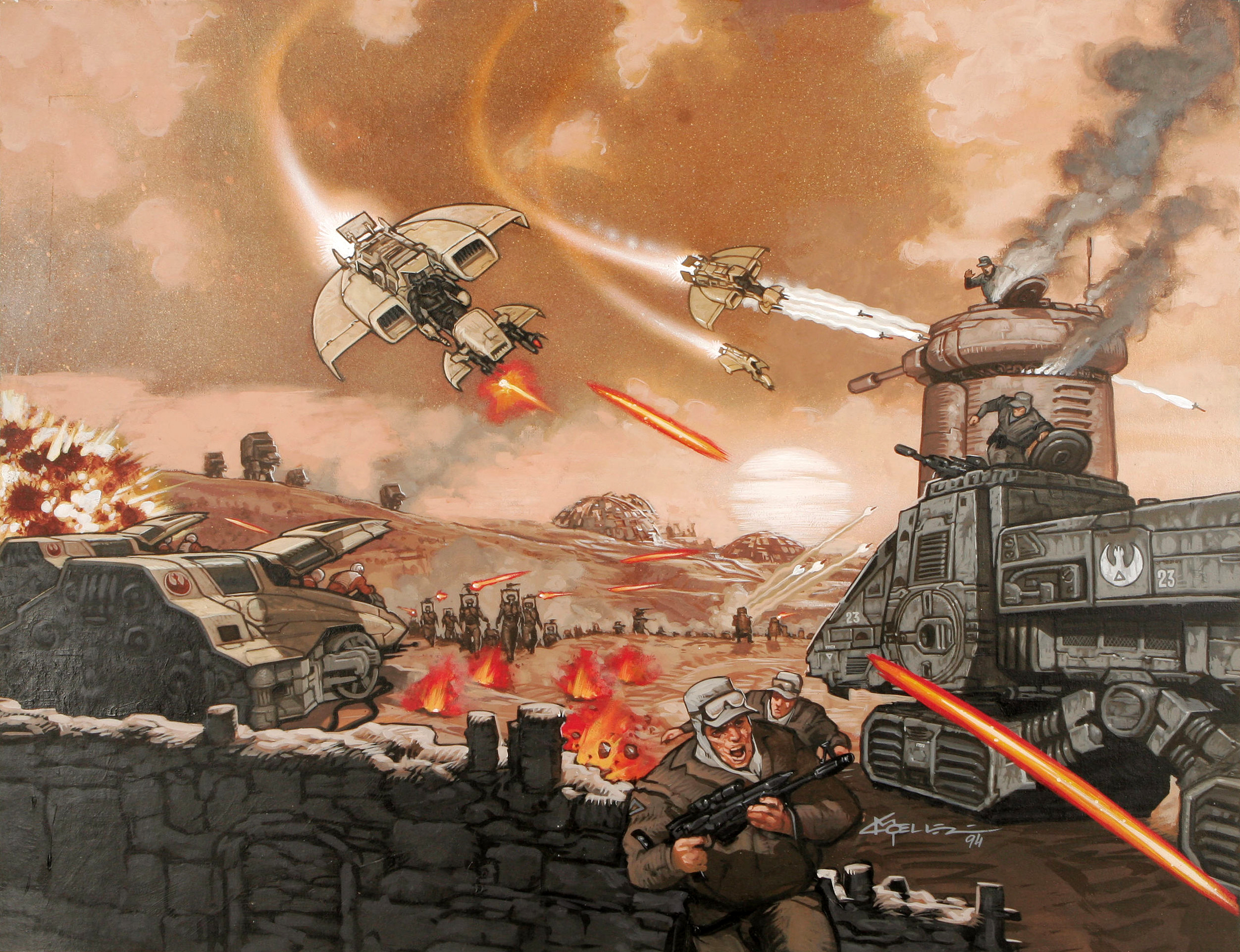
Moeller's artwork for The Battle of Cadinth, which featured several of the droids from The Epic Continues.
The three Imperial Attack Droids, as well as the sniper airspeeder and the Scout and Retrieval Vehicle, would be canonized in 1995, when Bill Smith used them in his short story entitled The Battle of Cadinth. The story, published in Star Wars Galaxy Magazine 2, gave the three droids new names: "AP-1-C attack droid," "AP-2 attack droid," and "AP-3 attack droid." An illustration by Christopher Moeller that accompanied the story showed these droids and vehicles in action. The Scout and Retrieval Vehicle was also used in the Star Wars: The Roleplaying Game supplement The DarkStryder Campaign, also published in 1995.
Another vehicle canonized, in some form, was the Tandem X-wing. The idea of the vehicle, rather than the design, was used in Randy Stradley's Crimson Empire II: Council of Blood, published in 1998. The XP-38 would also return in a different form, as it was rendered in 1996's The Essential Guide to Vehicles and Vessels, with a design completely different to the one submitted by Kenner. In 2004, The New Essential Guide to Weapons and Technology, written by W. Haden Blackman, canonized the All Terrain Ion Cannon vehicle. Finally, in 2011 the Falcons cargo handler appeared in the Millennium Falcon Owner's Workshop Manual as the Freight-loading external rover, and then was made part of the new canon in an updated version of that book, YT-1300 Millennium Falcon Owners' Workshop Manual in 2018.
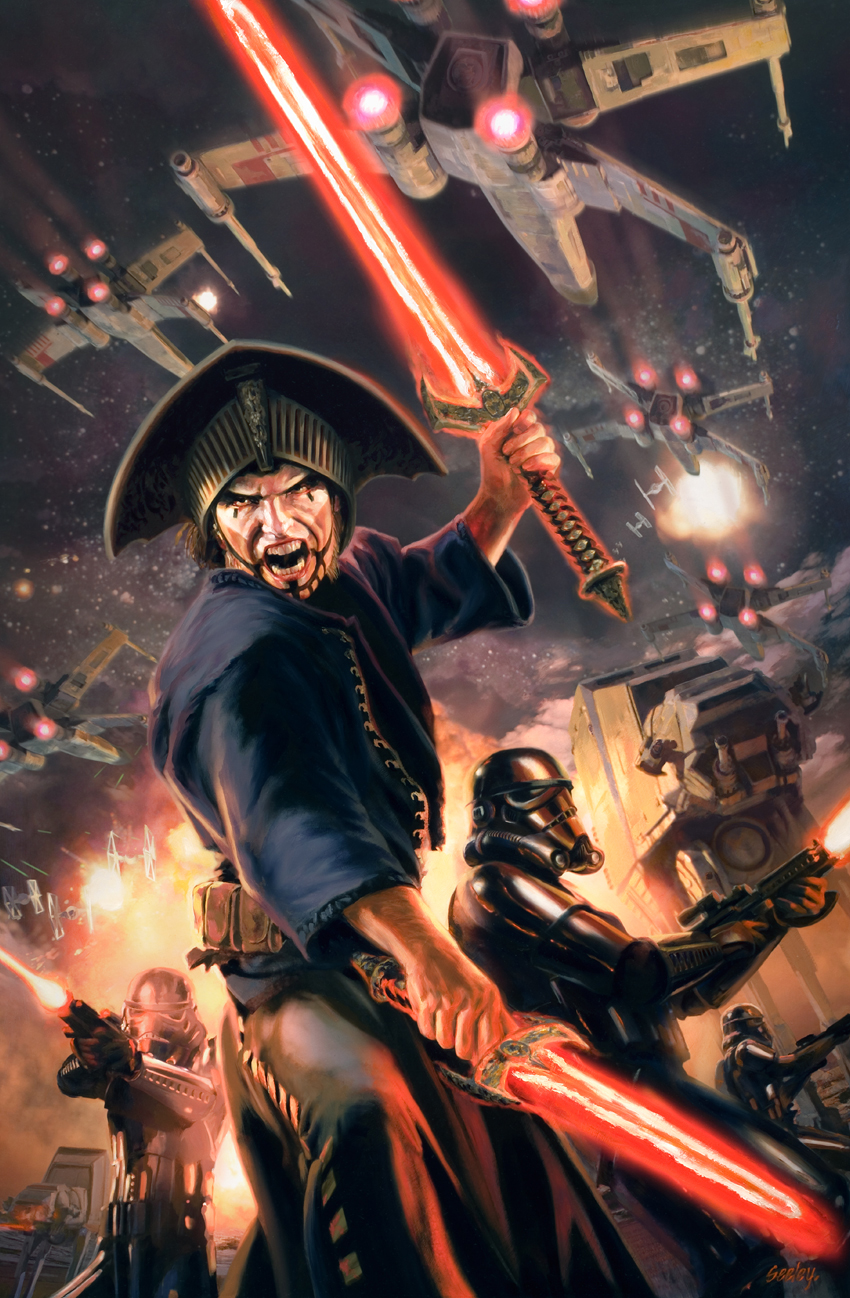
Shadowspawn, the character Abel G. Peña intended to consolidate with Atha Prime.
The same concept art that was the basis for Atha Prime was used by Cam Kennedy in Tom Veitch's Star Wars: Dark Empire comic series, published in 1991. The art inspired the Imperial Sentinels, the design of whom was in turn made into an action figure by Hasbro in 1998. While writing for issue 122 of the Official Star Wars Fact File, Abel G. Peña wrote a reference to Prime that connected him to the coup attempt featured in Star Wars: Empire: Betrayal, which also featured cloned soldiers. The reference, however, was cut during the editing stage. This did not stop Peña, and he would later make an attempt to consolidate the characters of Prime and Shadowspawn from the Dark Empire Sourcebook, written by Michael Allen Horne. Together with Daniel Wallace, Peña wrote an article on the Imperial Warlords, with the intent of having it published in Polyhedron magazine. The publication was canceled before such a thing could happen, leaving the connection, and Prime himself, non-canon.
Eventually, in the 2007 article he co-wrote with Rich Handley entitled Aliens in the Empire, Peña alluded to a "genetics terrorist" that was intended to be Prime, thus canonizing at least one element of the original character. A blurb of the 2008 novel, Matthew Stover's Luke Skywalker and the Shadows of Mindor, contained information about the main villain, Shadowspawn, that was similar in wording to specific elements of Kenner's original brief for Prime. This led to speculation on the Jedi Council Forums as to whether or not the consolidation of Prime and Shadowspawn was still to go ahead in the upcoming novel, but this proved to not be the case upon the release of the book itself, as Shadowspawn was instead consolidated with the character Cronal.